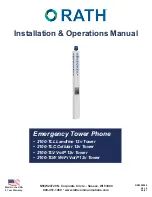
Basic Communication Procedures
Nur für den internen Gebrauch
A31003-S2000-R102-16-7620 02/2016
34
Provisioning Service, Developer’s Guide
c03.fm
Phone Driven Interactions
2. When the provisioning service has received the message from the phone, it sends an ap-
propriate response, including the nonce value received by the phone, and a session
cookie. The nonce value will be the same for all subsequent messages within this message
flow. In this response, the provisioning service may request all items from the phone in or-
der to gain comprehensive knowledge about its settings. However, if the phone is already
known to the provisioning service, it will be sufficient to look at the
configuration-
changed-flag
item. By setting it to
false
, the phone indicates that the configuration is
still the same as with the last data exchange. See the following example:
<DLSMessage
xsi:schemaLocation="http://mydomain/provisioning"
xmlns:xsi="http://www.w3.org/2001/XMLSchema-instance"
xmlns="http://mydomain/provisioning">
<Message nonce="ab15234de14f15a667c6f8d">
<Action>ReadAllItems</Action>
</Message>
</DLSMessage>
3. Next, the phone sends the desired data. Note the content of
ReasonForContact
and the
action
attribute:
<WorkpointMessage
xsi:schemaLocation="http://www.siemens.com/DLS"
xmlns:xsi="http://www.w3.org/2001/XMLSchema-instance"
xmlns="http://www.siemens.com/DLS">
<Message nonce="ab15234de14f15a667c6f8d">
<ReasonForContact action="ReadAllItems"
status="accepted">reply-to
</ReasonForContact>
<ItemList>
<Item name="...">...</Item>
<Item name="...">...</Item>
...
</ItemList>
</Message>
</WorkpointMessage>
















































